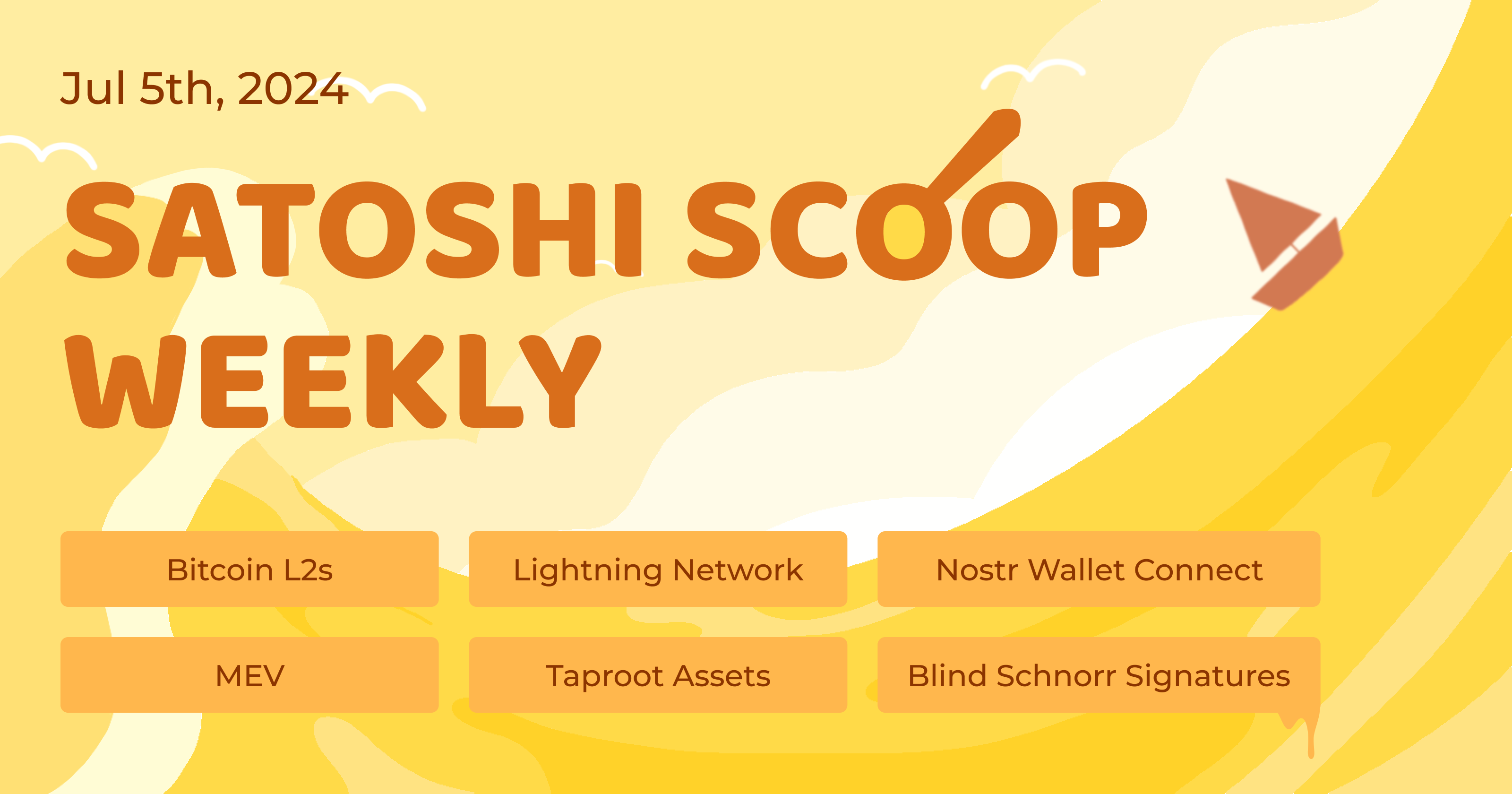Satoshi Scoop Weekly, 5 Jul 2024
 Cryptape
CryptapeTable of contents
- Crypto Insights
- ZKP2P: A New Peer-to-Peer Fiat On- and Off-Ramp Channel
- Risk Framework for Bitcoin Layer2s and Sidechains
- Bitcoin Lightning Alliance Using New Asset Protocol to Accelerate Adoption
- UTXO Stack: Complete Edition of the RGB++ Protocol Charting Bitcoin's Course
- Rebar Labs: Building MEV-Aware Infrastructure, Products, and Research for Bitcoin
- Estimating Likelihood of Lightning Payments (In)Feasibility
- Say Love in Secrets: How to Design a Bitcoin Inheritance Plan
- Toxic Marriage Between PWA Wallets and Bitcoin
- Lessons From a Decade Crypto Investing
- Top Reads on Blockchain and Beyond

Crypto Insights
ZKP2P: A New Peer-to-Peer Fiat On- and Off-Ramp Channel
ZKP2P is a trust-minimized P2P fiat on and offramp interoperable with all widely used Web2 payment channels.
ZKP2P protocol is driven by zero-knowledge proofs from DKIM (DomainKeys Identified Mail) signatures in payment confirmation emails. This allows for permissionless integration with Web2 payment networks, enabling users to unlock custody assets on-chain in a trustless manner after a successful off-chain payment and proof generation.
Risk Framework for Bitcoin Layer2s and Sidechains
The author is working on Bitcoin Layers, a project that assesses different Bitcoin L2s and sidechains. The criteria currently in use include:
Unilateral exit
Data availability
Block production
State validation (settlement)
However, the problem with the existing evaluation framework is that not all protocols consider the same goals in their designs, and they have different trade-offs. The author hopes to provide a more diverse and granular framework suitable for diverse projects;
The improvements made mainly include classifying the protocols as follows: data availability, network operators, settlement assurance (aka., finality), and bridge custody (aka., two-way peg).
Bitcoin Lightning Alliance Using New Asset Protocol to Accelerate Adoption
The Lightning Network Alliance led by LNFi, has proposed a new initiative focusing on accelerating Lightning Network adoption via standardization and collaboration. This is achieved using protocols such as Nostr and Taproot assets to enhance interoperability and user experience within the Bitcoin ecosystem, simplifying asset management and transactions;
Introduction of the LN Link standard: LN Link, an extension of Nostr Wallet Connect (NWC), facilitates Bitcoin applications to easily interact with Taproot assets;
Taproot assets integration into LN: Taproot assets allow advanced scripting and off-chain data commitment in UTXO, making them highly scalable without increasing blockchain bloat.
UTXO Stack: Complete Edition of the RGB++ Protocol Charting Bitcoin's Course
Isomorphic binding with RGB++ protocol pairs Bitcoin UTXOs with off-chain data, allowing asset transfers that execute as if off-chain while ensuring accuracy verified by an auxiliary chain like CKB, with user options for independent verification.
Cross-chain Leap enables direct asset transfers between blockchains without the need for bridges, by simply adjusting the binding data structure and preserving asset value.
Rebar Labs: Building MEV-Aware Infrastructure, Products, and Research for Bitcoin
This project focuses on the emerging MEV (Miner-Extractable Value) landscape in Bitcoin from the following three aspects:
Infrastructure: Launching an alternative to the public mempool via private transactions, providing new sources of income for miners as block rewards decrease, optimizing block construction and fees;
Products: Creating tools to demisify Bitcoin’s new on-chain ecosystem and illuminate MEV as it emerges, including data products and dashboards to help with in-depth analysis of on-chain activities;
Research: Providing pioneering analysis reports around MEV on Bitcoin.
Estimating Likelihood of Lightning Payments (In)Feasibility
René Pickhardt posts a discussion on estimating the feasibility of lightning payments, given the public knowledge of a channel’s maximum capacity but no knowledge of the current balance distribution.
The likelihood of the feasibility of the lightning network clearly indicates that many LN payments that seem possible at first glance will not succeed in practice.
Say Love in Secrets: How to Design a Bitcoin Inheritance Plan
- What needs to be considered if you want to pass on your BTC after you’re gone? What are the common design approaches? How should ordinary BTC holders avoid pitfalls? (The language of the Podcast is Mandarin Chinese)
Toxic Marriage Between PWA Wallets and Bitcoin
The advantage of PWA (Progressive Web App) wallets is that they are independent from platforms like Apple or Google store. However, the author points out that PWAs cannot sign, verify, or reproduce, and they will self-update every time opened—these traits make the author worry about the security of PWA wallets and suggests that developers should provide safer alternatives.
The author assumes that attackers can have two options: one is wallets listed in the app store, and the other is PWA wallets; both are identical in attack surface, protecting an equivalent amount of Bitcoin. PWA wallets are easier targets for attackers because: 1. PWAs will self-update, allowing malicious code to reach more victims faster and provide a greater return; 2. PWAs lack signature generation, making attacks easier to execute with lower cost.
Lessons From a Decade Crypto Investing
Authenticity wins. Everything is open source and easily copied but first of a kind products lead to the biggest outcomes;
The intersection of purist and tourist is key for apps. Too purist and the product will stay niche. Too tourist and easy come, easy go.
Focus on what you like and don’t chase shiny objects just because other people like them. Chasing the popular narrative is the best way to lose your money.
Define risk/reward and take a long-term view.
User alignment is essential. There’s a lot of ways to extract value from people and the weak will extract. You can make a buck that way, but nothing meaningful.
Top Reads on Blockchain and Beyond
Research Paper: Concurrently Secure Blind Schnorr Signatures
Abstract: Many applications of blind signatures, e.g. in blockchains, require compatibility of the resulting signatures with the existing system. This makes blind issuing of Schnorr signatures (now being standardized and supported by major cryptocurrencies) desirable. Concurrent security of the signing protocol is required to thwart denial-of-service attacks. We present a concurrently secure blind-signing protocol for Schnorr signatures, using the standard primitives NIZK and PKE and assuming that Schnorr signatures themselves are unforgeable. Our protocol is the first to be compatible with standard Schnorr implementations over 256-bit elliptic curves. We cast our scheme as a generalization of blind and partially blind signatures: we introduce the notion of predicate blind signatures, in which the signer can define a predicate that the blindly signed message must satisfy. We provide implementations and benchmarks for various choices of primitives and scenarios, such as blindly signing Bitcoin transactions only when they meet certain conditions specified by the signer.
Nostr Wallet Connect: A Bitcoin Application Collaboration Layer
@AurtrianAjian: NWC was proposed quite early as an implementation possibility for Nostr protocol. It is essentially placing a Nostr client and a lightning node together. By messaging Nostr client, you can control the lightning node, initiate payments, and generate invoices.
This solves the problem of how to remotely control a lightning node deployed in your home network while you are away. Before Nostr, this involved long waits due to network latency or first getting an externally accessible IP address. Now, there are two NWC implementations, one can be paired with LND. If you know some programming, you can implement the same functionality as NWC in a non-standard way.
Broadly speaking, Bitcoin, Lightning, and Nostr are keys for personal online survival. They equip you to create a personal homepage: Nostr provides the display page and content, as well as an automated processing port for zapping. Your lightning node is under your control. All you need is these trust-minimized protocols.
Subscribe to my newsletter
Read articles from Cryptape directly inside your inbox. Subscribe to the newsletter, and don't miss out.
Written by
